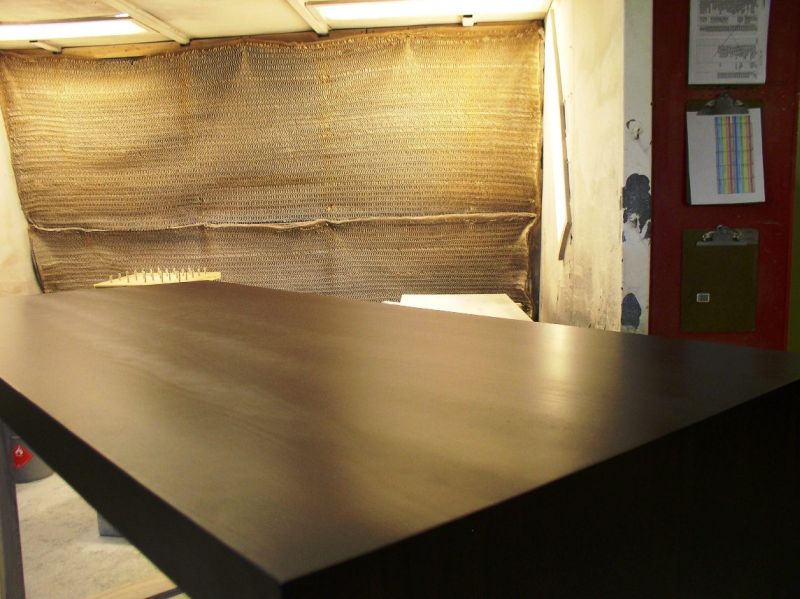Avoiding "Stripes" in a Flat Finish
Boxing the spray pattern with a criss-cross application may help avoid visible stripes or overlap streaks. December 30, 2007
Question
Our finishers are having a real problem spraying a dead flat conversion varnish on a tabletop. It is SW Kemvar LF CV. It is being catalyzed and sprayed at full viscosity with an airless sprayer and 410 FF tip. The finish is coming out very smooth. It is being sprayed on a dark chocolate stain and is showing what look like dry spray lines, but are not. There is what looks like a sheen difference in the stripes. We have sprayed this in the past with no problems except when it comes to tops. Should this stuff be continually agitated or what?

Click here for higher quality, full size image
Forum Responses
(Finishing Forum)
From contributor A:
If these are not spray lines, then it's probably an uneven wet film thickness issue. If the thickness of the wet film is uneven, you will have more flatteners in some areas and less in others. Also the thinner areas will appear flatter, as the flatteners are closer to the surface in a thinner film.
Get a 2' x 4' test panel and use a wet film thickness gauge and apply the product 3-5 mils wet. Ensure that you lap the gun 50% on each pass. Also start at the far end and work your way toward the fan.
If this is already what you do, then I'm not sure what the problem might be other than bad finish or the surface isn't sealed properly.
From contributor J:
A quick method to see if your pattern is uneven is to spray your gun with a horizontal pattern at a vertical surface. Don't move the gun. If it runs more on the outside of your pattern, it's uneven. You might need a new tip, or less fluid pressure.
From contributor C:
Uneven spraying is the problem you are dealing with. I would box spray it. Dead flat is a bit tricky. Stir just before you spray, coat very thinly, move fast, box coat (from two, three, or four directions). That ought to bring you home. You are either getting some strips too wet or too dry. Theoretically it can be done with passes all from the same direction, but practically speaking it is harder than it needs to be when done that way.
From contributor G:
How about thinning 5% and adding some retarder to your mix?
From contributor T:
Try putting on another coat. That should even it out.
From contributor L:
I have to agree with the overlapping of finish. In an airless, if your pattern is off even a little bit, it'll streak.
From contributor P:
Spraying wet on wet at 90 degrees (box coat) works for me. I've tried adding thinner and/or retarder, spraying heavy or light coats, holding the gun off the surface more than normal, making sure to keep the gun perpendicular to the surface, and overlapping each pass as much as 80%, all without getting consistently good results. It doesn't get better with added coats.
Watch out for your total dry film thickness. Sand the existing coat back fairly aggressively before recoating - especially since you will be essentially applying two coats when you box coat.
From contributor T:
Just a thought... Has anyone tried spraying in one direction only instead of the usual back and forth pattern?
From contributor M:
Maybe this is too obvious, but have you checked all the air nozzle openings? Are they perfectly clean? Just a small piece of dried finish will effect the spray pattern dramatically. Also the fluid nozzle should be cleaned, and make sure there is no dried finish in there either. Check the spray pattern on a piece of cardboard without moving the gun. Is the shape a perfect oval? If it is lopsided, there is a problem with the tip.
From the original questioner:
Thanks. I had him change out the tip because it was a little heavy on the outsides of the pattern. They came out a little better. One is consistently cloudy looking all the way through now. But thank you. Does anyone use different finishes for that dead flat look? We use SW Kemvar LF and that is all we have used ever.
